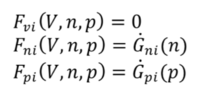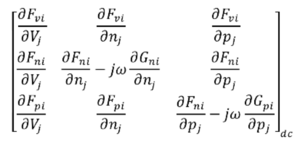Device Solves: Difference between revisions
No edit summary |
|||
| Line 43: | Line 43: | ||
Small-signal of 100 Hz is applied at the chosen contact. | Small-signal of 100 Hz is applied at the chosen contact. | ||
For a highly doped resistor, consider | For a highly doped resistor, consider just electron current. | ||
set Re_cur ([contact name=VSS sol=Elec flux acreal])] | set Re_cur ([contact name=VSS sol=Elec flux acreal])] | ||
Revision as of 19:01, 5 January 2016
FLOODS Specific Commands
- Initial Guess - start the numerical solve off well
- contact - define contacts physically, and define contact physics
- device - bias contacts and solve steady-state or transient
Steady-State
Transient
Small-signal analysis
Sinusoidal Steady State Analysis is typically used to obtain capacitance, transconductance, current-gain and cut-off frequencies. Consider the symbolic representation of the 3 device equations: Poisson, electron and hole continuity equations.
The dot term represents the time derivative component of the electron and hole electron continuity equations. Sinusoidal Steady State Analysis (S3A) solves the device equation system in the frequency domain as a steady state perturbed by an infinitesimal signal. The small signal assumption allows linearization of the device around the DC bias point. The corresponding Jacobian takes the symbolic form:
which is a 3Nx3N matrix (for 3 solution variables and N nodes). Notice the imaginary frequency dependent components in the electron and hole rows corresponding to the time derivative dot term in the continuity equation. The matrix equation now takes a form slightly different to the steady-state form JX=B.
where J remains the steady-state Jacobian at the desired DC-bias point, D is now a diagonal matrix with zeros for Poisson rows and ω=2πf for diagonal elements of continuity rows. Both are 3Nx3N matrices. X is solution vector and B is boundary condition vector. For computational reasons(i.e. seperating real and imaginary terms), the matrix system takes the following 6Nx6N form
where XR and XI are real and imaginary components of the solution variables.
Examples
device contact name=VSS voltage supply=1.0 acreal contact name=VSS voltage supply=0.0 acimag device freq=100
First device does a steady-state solution at previously provided bias point. Setting "real" supply to unity would be recommended as response is linear (also convenient for obtaining conductance). Small-signal of 100 Hz is applied at the chosen contact.
For a highly doped resistor, consider just electron current.
set Re_cur ([contact name=VSS sol=Elec flux acreal])] set Im_cur ([contact name=VSS sol=Elec flux acimag])]
As expected for low resistance, real current Re_cur will be high and imaginary current Im_cur due to capacitive component will be extremely low.


